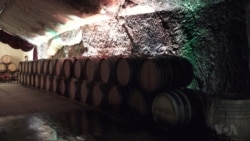In a cave in California’s famed wine country, there is a forgotten past that surprises many people when they visit. On a tour of the Buena Vista Winery in Sonoma County, visitors will learn that it proudly calls itself California’s first premium winery. Founded in 1857, the people who helped build the winery came from far away.
“From the late 1850's to the 1870's, they primarily were Chinese laborers. They actually built our building and played a huge role in the founding of Buena Vista,” said Tom Blackwood, general manager of Buena Vista Winery.
The California Gold Rush in the mid-1800s brought a lot of people to America's West Coast seeking to strike it rich, including people from China. After the Gold Rush, many of the Chinese stayed and worked as unskilled laborers, including in the construction of the railroads. A lesser known fact is that some of them also traveled north of San Francisco and worked in the infant vineyards.
“They did all of the work of the fields, the plowing. The actual digging, planting and then the management of all the vineyards,” said Blackwood. “They definitely worked at the other properties, but Buena Vista was known to have the largest Chinese labor camp north of San Francisco.”
The Chinese workers also dug the cave at Buena Vista Winery that stored the wine so it could age. Pick marks on the walls of the cave can still be seen. The rocks dug from the cave were used as building blocks for the wine-making facilities at the time, and two of the original buildings still remain today.
Local residents said signs of the Chinese laborers also can be seen outside the winery.
“A couple of my friends [they] showed me, the so-called ‘Chinese rock fence,’” said Chinese American Jack Ding, pointing to a low fence made of rocks at the side of a busy road. “Local people, they still remember Chinese laborers did something for them.”
The work done by the Chinese laborers has been passed down by word of mouth among the locals. Historians also know about them, but what happened to them is somewhat of a mystery.
“We don’t understand where they went after they left the city of Sonoma. We don’t know a whole lot of names,” said former Sonoma city historian George McKale.
Chinese immigrants at the time experienced violent anti-Chinese sentiment, boycotts, and in 1882, the Chinese Exclusion Act, a law that restricted immigration into the United States.
“They work here. They live here. Most of them, they die here. They didn’t have a place to be buried,” said Ding.
“This was sort of the forgotten history of Sonoma. We had sort of a shameful history regarding the Asia [Chinese] Exclusion Act and people want to make things right,” said resident David Katz.
Katz and Ding are members of the Sonoma-Penglai Sister City Committee that has launched an effort called the Wine Country Chinese Legacy Project. The goal is to honor the nameless Chinese laborers of the early wine industry by building a Chinese-style gazebo or pavilion, called a ting, at Depot Park in the city of Sonoma.
Committee members said its Chinese sister city of Penglai has pledged $25,000 toward building the outdoor structure. It will be called Penglai Pavilion, and the goal is to raise a total of $75,000.
The pavilion also would be an opportunity to educate the new generation of Chinese who are coming to the wine country about the history of their fellow citizens, said Ding.
“We can see a lot of investors from China. They purchase wineries. They purchase properties. That is the reason why we want to build this kind of physical structure, to remind the people, remind them of the history, who we are. Where we came from.”
If fundraising efforts are successful, the committee aims to break ground for the pavilion by the end of summer.






